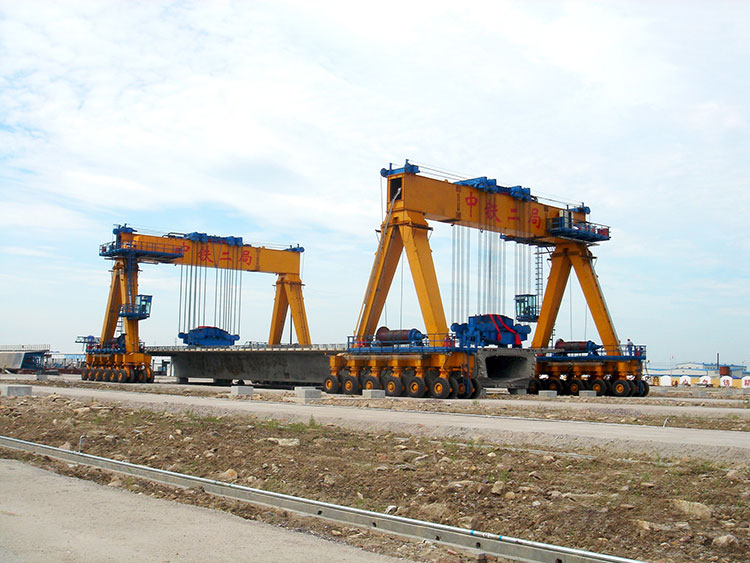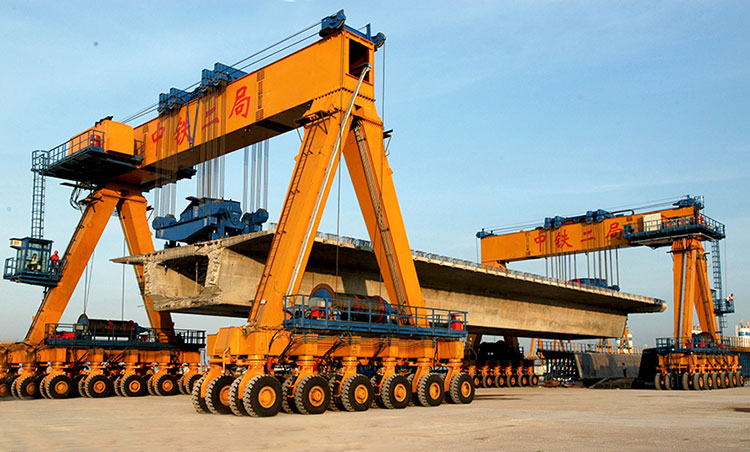In heavy lifting environments such as container terminals, precast concrete yards, steel stockyards, and large-scale manufacturing plants, the demand for handling oversized or overweight loads often surpasses the lifting limits of a single crane. In such cases, tandem operation of two Rubber Tyred Gantry (RTG) cranes emerges as a practical, flexible, and efficient solution. By synchronizing the operation of two mobile gantry cranes, operators can effectively double the lifting capacity and expand the scope of handling extremely long or heavy items.
This article explores the technical considerations, applications, safety requirements, and advantages of tandem rubber tyre gantry crane operation, helping industrial users understand how to deploy this lifting method to improve productivity and project feasibility.

What Is Tandem Operation?
Tandem operation involves the simultaneous and coordinated use of two RTG cranes to lift, transport, and place a single heavy or elongated load that exceeds the capability of one crane. This method is commonly used when lifting:
-
Extra-long precast concrete beams
-
Steel structural elements
-
Wind turbine components
-
Oversized machinery or industrial equipment
-
Boats or marine vessels
-
Containerized project cargo with unusual dimensions
In tandem mode, each mobile gantry crane is responsible for a portion of the load. The cranes are controlled either through a synchronized control system or with precise manual coordination, ensuring that both units move in harmony to avoid damaging the load or creating unsafe lifting conditions.
Key Applications of Tandem RTG Operation
-
Precast Concrete Yards
In precast concrete production plants, large bridge girders or tunnel segments often weigh between 50 to 100 tons and can extend over 30 meters in length. Two RTG cranes working in tandem allow seamless lifting, flipping, and stacking of such elements. -
Steel Fabrication and Stockyards
Long steel beams and heavy assemblies often need dual-point lifting. RTG cranes provide the mobility and lifting range needed for such applications, especially where the yard layout is not fixed. -
Shipyards and Marine Industry
For lifting yachts, catamarans, or boat hulls with high weight and span, tandem crane lifting ensures safe handling during repairs, manufacturing, or launch. -
Construction of Wind Turbine Components
Towers and blades require careful dual-lifting techniques due to their length and sensitivity to deflection and damage. RTG cranes provide a mobile and precise option. -
Large Industrial Equipment Handling
In power plants or heavy industry manufacturing, large transformers, turbines, or pressure vessels are best handled with tandem-lifting RTGs, especially when onsite cranes are limited.

Technical Considerations for Tandem RTG Operation
1. Crane Compatibility
Both RTG cranes must be structurally and mechanically compatible in terms of:
-
Lifting capacity
-
Span and lifting height
-
Wheel configuration and steering modes
-
Travel speed and acceleration
-
Control systems and synchronization capability
It is ideal to use identical or similarly configured cranes for uniform load distribution.
2. Load Distribution
Load must be evenly shared between the two rubber wheeled gantry cranes to avoid:
-
Overloading one crane
-
Uneven stress on the load
-
Dangerous tilting or swaying during movement
Advanced load-monitoring systems are often used to track and adjust lifting force in real-time.
3. Synchronization System
Depending on the control setup, cranes can be operated:
-
Independently with voice or radio communication (higher risk)
-
Semi-synchronized with linked controls
-
Fully synchronized via integrated tandem operation control system
For high precision applications, a tandem synchronization system is preferred. It connects the cranes electronically and allows one operator to control both cranes simultaneously.
4. Lifting Gear and Spreaders
Special spreaders or lifting beams may be required to connect the two hoisting points and ensure uniform load support. Common tools include:
-
Dual-point lifting beams
-
Custom spreader bars
-
Sling assemblies with equalizer sheaves
Lifting accessories must be engineered to match the combined load and geometry of the object.
Safety Considerations
Safety is a top priority in tandem lifting operations due to the increased complexity and potential risk. The following precautions must be taken:
-
Operator Training: Operators should be specially trained in tandem crane operations, including emergency procedures.
-
Load Testing: A pre-operation test lift must be performed to validate load sharing and crane synchronization.
-
Communication: Reliable radio communication is essential between crane operators and ground personnel.
-
Lifting Plan: A detailed lift plan including path, speeds, and hoisting points must be prepared and reviewed.
-
Emergency Stop Protocols: Both cranes must be able to stop immediately and simultaneously in case of any irregularities.
Advantages of Tandem Operation with RTG Cranes
1. Increased Lifting Capacity
By combining the capacities of two cranes, users can double the effective lifting capability, enabling them to lift loads of 100 tons or more without needing to invest in a larger fixed crane.
2. Greater Flexibility and Mobility
Unlike fixed gantry systems, rubber tyred gantry cranes are mobile, allowing tandem lifting operations across different parts of a yard or facility. This is especially beneficial for changing layouts or large storage areas.
3. Cost Efficiency
Investing in two medium-capacity RTG cranes and configuring them for tandem use is often more cost-effective than purchasing a single, ultra heavy duty gantry crane.
4. Reduced Site Congestion
Two mobile cranes can approach a load from different angles or directions, minimizing interference with ongoing operations and requiring less foundation work compared to rail-mounted systems.
Case Example: Tandem RTG Operation for Precast Concrete Beam Handling
In one real-world scenario, a precast concrete manufacturing company implemented tandem lifting with two 50-ton rubber tyred gantry cranes to handle 80-ton bridge girders measuring over 32 meters long. The cranes were equipped with dual hoisting points and custom spreaders to secure the beams.
Through synchronized operation and precise load monitoring, the company achieved:
-
Smooth lifting and placement of long beams
-
Reduced risk of load imbalance or cracking
-
Improved yard space utilization due to RTG mobility
-
Elimination of costly and space-consuming rail-mounted alternatives
Conclusion
The tandem operation of rubber tyred gantry cranes represents a powerful and flexible solution for lifting large, heavy, or irregular loads across various industries. By leveraging synchronized control systems, advanced lifting gear, and proper safety protocols, businesses can expand their lifting capabilities, reduce operational bottlenecks, and increase overall efficiency.
Whether in precast concrete production, shipbuilding, steel fabrication, or heavy equipment handling, tandem RTG crane operations provide a versatile and cost-effective alternative to single-crane setups or permanent infrastructure investments.
For organizations looking to upgrade their lifting capacity without sacrificing mobility or budget, tandem RTG operation is a forward-thinking strategy that unlocks new possibilities in material handling.